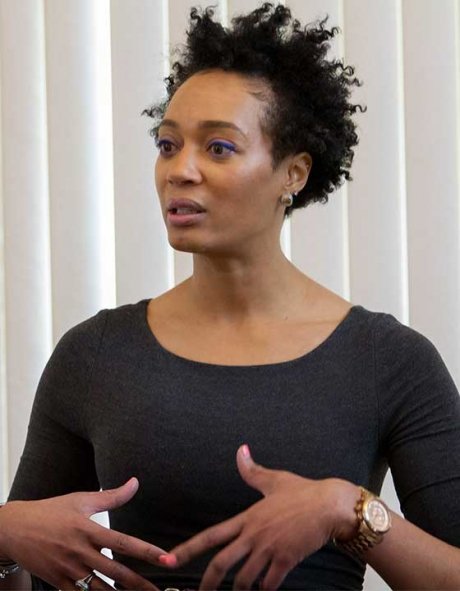
“Imagine a Trinidadian carnival full of vibrant colors, costumes, drumbeats, whistles and horns. Imagine the smells, the sweat rolling down your back, the call and response.”
Dancer/choreographer A’Keitha Carey is describing a dance form she created called CaribFunk – a fusion of Afro-Caribbean, classical ballet and modern dance, with fitness elements.
“There is an energy of celebration that needs to happen in this movement and you are feeding that energy to your partner,” she said.
The term “Carib” signifies the dance’s Afro-Caribbean roots. "Funk” signifies the uniquely individual element one brings to this movement. Then there’s the “hip wine,” the circular rotation of the hip, that is central to CaribFunk.
“It’s a torso-hip-knee rotation, a figure-eight movement of the hips,” she explained.
More than 50 RIC students attended two of Carey’s CaribFunk dance classes and more than 30 faculty and students attended her lecture to experience “the power of the hip wine.”
Following the hips-on experience, Carey asked the predominantly female audience, “How did it make you feel?” Upon expressing “good” feelings, Carey asked, “Why did it make you feel good?” Comments included “I felt a sense of freedom,” “I felt a sense of release.”
Hip wine is “embodied freedom,” Carey explained. It is freedom of body and movement. The roots of the hip wine is West African (Congolese) dance; however, the movement can be found throughout the African continent and the Latin diaspora (in dance forms such as salsa, merengue and samba).
Though these movements are indigenous to non-Western cultures and have been appropriated and transformed by Western popular culture, as seen in hip hop, the hip wine has often been sexualized by Western society and deemed inappropriate or not respectable, she said.
“When a woman is free in her body, people often become afraid. They want to control her body, perhaps because they are projecting their own sexuality onto her or because they themselves were controlled or shamed in the same way.”
“I am looking at how women, particularly women of color, can find identity through freedom of the body without being policed or shamed,” she said. The hip wine is both “embodied freedom” and “embodied protest.”
Carey argues that there is a need for higher education to incorporate a broader perspective of society, class, race, culture and identity in the dance curriculum. “I’d like to see a curriculum that addresses the needs of students who are bringing diverse, multiracial, multicultural and transnational experiences into the classroom. That is my mission,” she said.
